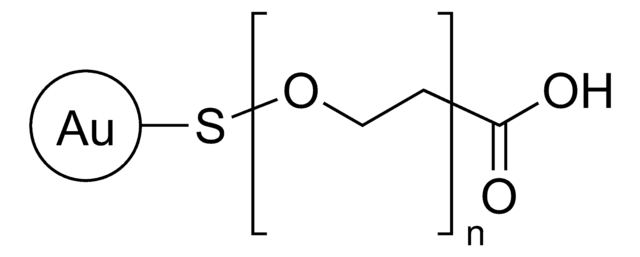推荐产品
材料
PEG 5000
形狀
dispersion in H2O
nanoparticles
包裝
poly bottle of 1 mL
外徑
50
直徑
15 nm
pH值
6.0-8.0 (25 °C)
溶解度
water: miscible
密度
1.00 g/cm3
λmax
520 nm
官能基
methoxy
儲存溫度
2-8°C
正在寻找类似产品? 访问 产品对比指南
一般說明
Gold nanoparticles (AuNPs) ranging from 2-200nm in diameter find applications in diverse fields. They show excellent biocompatibility and attractive physicochemical properties. AuNPs are shown to be highly sensitive colloidal biosensors. The poly (ethylene) glycol (PEG) coating on gold nanoparticles helps in the reduction of protein adsorption, reduces nonspecific interactions with cells and greatly improves the pharmokinetics of these nanoparticles and disables aggregation of the nanoparticles.PEG layer density depends inversely on the AuNP curvature. AuNPs coated with PEG 5000 exhibited the highest colloidal stability. The methyl group, being hydrophobic acts as a protecting shield between the gold nanoparticles and the hydrophilic outer PEG coating and also leads to a further reduction of protein adsorption and macrophage uptake by the AuNPs.
應用
Several other specific applications have been listed below:
- Since they adhere to cell membranes, AuNPs may find use in cellular and intracellular targeting in targeted drug delivery applications and may also used in biodistribution studies.
- AuNPs may also be used in photothermal therapy and radiotherapy.
- AuNPs ranging from 10 to 250 nm, were studied to have been absorbed primarily by liver and spleen, when injected intravenously in rats.Whereas, 10 nm nanoparticles were distributed more broadly into various organs.
Functionalized Particles have been extensively used to study cellular uptake of nanoparticles and targeted drug delivery.
特點和優勢
PEG decreases the cytotoxicity and increases efficiency of GNPs in targeted drug delivery. PEG increases the stability of the nanoparticles and prevents agglomeration. Forms complexes easily with dyes and thiol ligands.
儲存類別代碼
12 - Non Combustible Liquids
水污染物質分類(WGK)
WGK 1
閃點(°F)
Not applicable
閃點(°C)
Not applicable
其他客户在看
Xiao-Dong Zhang et al.
International journal of nanomedicine, 6, 2071-2081 (2011-10-07)
Gold nanoparticle toxicity research is currently leading towards the in vivo experiment. Most toxicology data show that the surface chemistry and physical dimensions of gold nanoparticles play an important role in toxicity. Here, we present the in vivo toxicity of
Timothy A Larson et al.
ACS nano, 6(10), 9182-9190 (2012-09-27)
Polyethylene glycol (PEG) surface coatings are widely used to render stealth properties to nanoparticles in biological applications. There is abundant literature on the benefits of PEG coatings and their ability to reduce protein adsorption, to diminish nonspecific interactions with cells
Functionalized gold nanoparticles and their biomedical applications
Tiwari, P. M., Vig, K., Dennis, V. A., & Singh, S. R.
Nanomaterials, 1(1), 31-63 (2011)
商品
Biomaterials science involves the design and fabrication of smart materials for studying, directing, or mimicking biology. For successful integration of biomaterials in biological research, a meaningful understanding of biological systems is required.
我们的科学家团队拥有各种研究领域经验,包括生命科学、材料科学、化学合成、色谱、分析及许多其他领域.
联系技术服务部门


